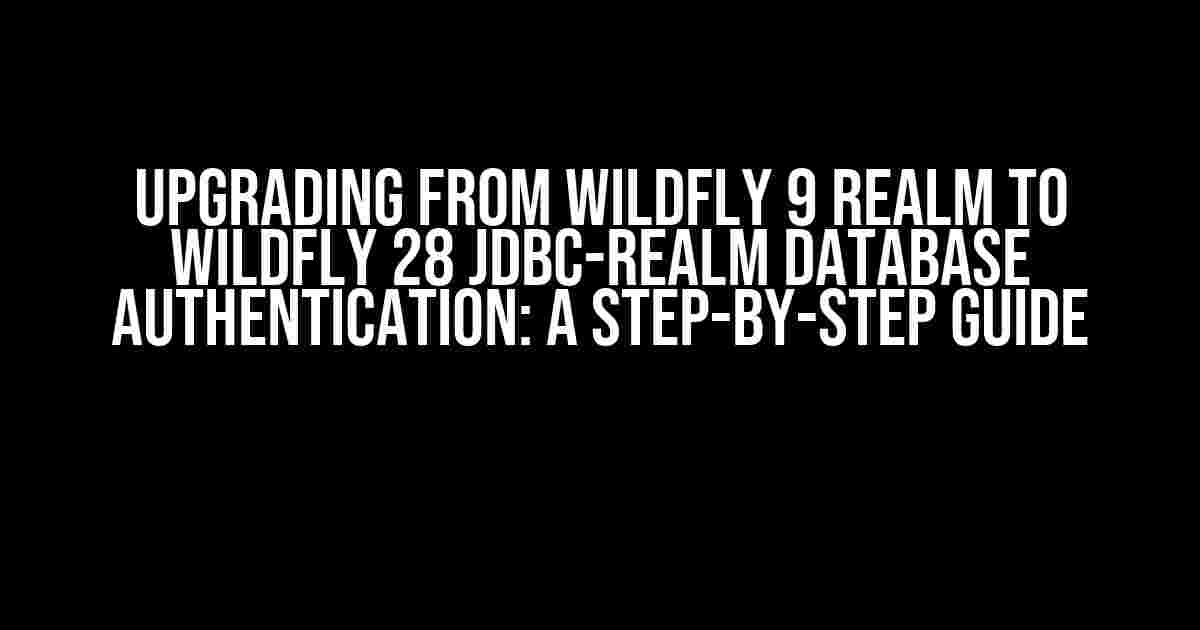If you’re still using Wildfly 9 Realm for database authentication, it’s time to upgrade to Wildfly 28 JDBC-Realm. The newer version offers improved security, better performance, and enhanced features. In this article, we’ll take you through the process of migrating from Wildfly 9 Realm to Wildfly 28 JDBC-Realm, ensuring a seamless transition to a more robust and reliable database authentication system.
What’s Changing?
Before we dive into the migration process, let’s understand the key differences between Wildfly 9 Realm and Wildfly 28 JDBC-Realm:
- Realm vs. JDBC-Realm: Wildfly 9 uses the Realm security domain, whereas Wildfly 28 uses JDBC-Realm. This change brings improved security and flexibility to your database authentication.
- Database Configuration: In Wildfly 9, database configuration is scattered across multiple files. With Wildfly 28, you can configure your database connections using a single file, making it easier to manage and maintain.
- Security Enhancements: Wildfly 28 introduces improved security features, such as password hashing and salting, to protect your database credentials.
Step 1: Prepare Your Environment
Before migrating to Wildfly 28 JDBC-Realm, ensure you have the following components installed and configured:
- Java 8 or Higher: Wildfly 28 requires Java 8 or later to function correctly.
- Wildfly 28 Server: Install the latest version of Wildfly 28 on your server.
- Database Server: Ensure your database server is running and configured to accept connections.
Step 2: Configure JDBC-Realm
Create a new file named `jdbc-realm.xml` in the Wildfly 28 server’s configuration directory (`standalone/configuration` for standalone mode or `domain/configuration` for domain mode). Add the following content to the file:
<jdbc-realm name="jdbc-realm-example">
<authentication-jQUERY>
<login-module code="org.jboss.security.auth.spi.DatabaseServerLoginModule" flag="required">
<module-option name="dsJndiName" value="java:jboss/datasources/ExampleDS"/>
<module-option name="principalsQuery" value="SELECT password FROM users WHERE username=?"/>
<module-option name="rolesQuery" value="SELECT role, 'Roles' FROM user_roles where username=?"/>
</login-module>
</authentication-jQUERY>
</jdbc-realm>
Modify the `dsJndiName`, `principalsQuery`, and `rolesQuery` values to match your database configuration.
Step 3: Configure Database Connection
Create a new file named `datasources.xml` in the Wildfly 28 server’s configuration directory. Add the following content to the file:
<datasources>
<datasource jndi-name="java:jboss/datasources/ExampleDS" pool-name="ExampleDS">
<connection-url>jdbc:postgresql://localhost:5432/exampledb</connection-url>
<driver>org.postgresql.Driver</driver>
<security>
<user-name>example_user</user-name>
<password>example_password</password>
</security>
</datasource>
</datasources>
Replace the connection URL, driver, username, and password values with your database credentials.
Step 4: Configure Security Domain
Edit the `jboss-web.xml` file in the Wildfly 28 server’s configuration directory to configure the security domain:
<jboss-web> <security-domain>jdbc-realm-example</security-domain> </jboss-web>
Update the `security-domain` value to match the name of your JDBC-Realm configuration (e.g., `jdbc-realm-example`).
Step 5: Test Your Configuration
Restart the Wildfly 28 server and test your database authentication using a tool like curl or a web browser:
curl -X GET \ http://localhost:8080/your_app \ -H 'Authorization: Basic dXNlcjpwYXNzd29yZA==' \ -v
Replace `http://localhost:8080/your_app` with the URL of your application. If everything is configured correctly, you should receive a successful response.
Troubleshooting Common Issues
If you encounter issues during the migration process, refer to the following troubleshooting tips:
- Check database connectivity: Ensure your database server is running and accepting connections. Verify the database credentials and connection URL.
- Verify JDBC-Realm configuration: Double-check the `jdbc-realm.xml` file for typos and incorrect values. Ensure the `dsJndiName`, `principalsQuery`, and `rolesQuery` values match your database configuration.
- Review security domain configuration: Verify the `jboss-web.xml` file is correctly configured, and the `security-domain` value matches the name of your JDBC-Realm configuration.
Conclusion
Migrating from Wildfly 9 Realm to Wildfly 28 JDBC-Realm requires careful planning and execution. By following this step-by-step guide, you’ll ensure a seamless transition to a more robust and reliable database authentication system. Remember to test your configuration thoroughly to avoid any issues.
| Wildfly 9 Realm | Wildfly 28 JDBC-Realm |
|---|---|
| Realm security domain | JDBC-Realm security domain |
| Database configuration scattered across multiple files | Single file configuration for database connections |
| Limited security features | Improved security features, including password hashing and salting |
By upgrading to Wildfly 28 JDBC-Realm, you’ll benefit from improved security, better performance, and enhanced features. Take the first step towards a more secure and reliable database authentication system today!
Recommended reading:
Here are the 5 Questions and Answers about “Wildfly 9 realm to Wildfly 28 jdbc-realm database authentication”:
Frequently Asked Question
In this section, we’ll explore the most common queries related to migrating from Wildfly 9 realm to Wildfly 28 jdbc-realm database authentication. Let’s dive in!
What’s the main difference between Wildfly 9 realm and Wildfly 28 jdbc-realm?
The main difference lies in the way they handle authentication. Wildfly 9 realm uses a proprietary security realm, whereas Wildfly 28 jdbc-realm leverages a JDBC-compliant database for authentication, making it more flexible and scalable.
Why should I upgrade from Wildfly 9 realm to Wildfly 28 jdbc-realm?
Upgrading to Wildfly 28 jdbc-realm brings numerous benefits, including improved security, easier maintenance, and better performance. Additionally, Wildfly 28 provides newer features, bug fixes, and support for latest Java versions.
How do I configure Wildfly 28 jdbc-realm to use an external database?
To configure Wildfly 28 jdbc-realm with an external database, create a datasource in the Wildfly 28 configuration file (standalone.xml/domain.xml), define the JDBC driver, and then configure the jdbc-realm to use that datasource.
Will my existing Wildfly 9 realm configuration work with Wildfly 28 jdbc-realm?
Unfortunately, no. The configuration files and formats have changed between Wildfly 9 and Wildfly 28, so you’ll need to recreate your configuration to accommodate the new jdbc-realm format.
What kind of database is required for Wildfly 28 jdbc-realm?
Wildfly 28 jdbc-realm supports a wide range of JDBC-compliant databases, including MySQL, PostgreSQL, Oracle, and Microsoft SQL Server, among others. Choose a database that aligns with your organization’s infrastructure and needs.
